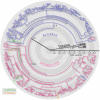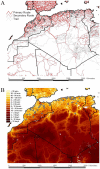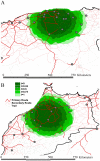Phylodynamics and human-mediated dispersal of a zoonotic virus
- PMID: 21060816
- PMCID: PMC2965766
- DOI: 10.1371/journal.ppat.1001166
Phylodynamics and human-mediated dispersal of a zoonotic virus
Erratum in
- PLoS Pathog. 2011;7(1). doi: 10.1371/annotation/66c3b26f-7b78-4412-96d0-c960b8d74b50. Jalal, Nourlil [corrected to Nourlil, Jalal]
Abstract
Understanding the role of humans in the dispersal of predominantly animal pathogens is essential for their control. We used newly developed Bayesian phylogeographic methods to unravel the dynamics and determinants of the spread of dog rabies virus (RABV) in North Africa. Each of the countries studied exhibited largely disconnected spatial dynamics with major geopolitical boundaries acting as barriers to gene flow. Road distances proved to be better predictors of the movement of dog RABV than accessibility or raw geographical distance, with occasional long distance and rapid spread within each of these countries. Using simulations that bridge phylodynamics and spatial epidemiology, we demonstrate that the contemporary viral distribution extends beyond that expected for RABV transmission in African dog populations. These results are strongly supportive of human-mediated dispersal, and demonstrate how an integrated phylogeographic approach will turn viral genetic data into a powerful asset for characterizing, predicting, and potentially controlling the spatial spread of pathogens.
Conflict of interest statement
The authors have declared that no competing interests exist.
Figures




References
-
- Cleaveland S, Meslin FX, Breiman R. Dogs can play useful role as sentinel hosts for disease. Nature. 2006;440:605. - PubMed
-
- Fevre EM, Kaboyo RW, Persson V, Edelsten M, Coleman PG, et al. The epidemiology of animal bite injuries in Uganda and projections of the burden of rabies. Trop Med Int Health. 2005;10:790–798. - PubMed
-
- Nel LH, Rupprecht CE. Emergence of lyssaviruses in the Old World: the case of Africa. Curr Top Microbiol Immunol. 2007;315:161–193. - PubMed

